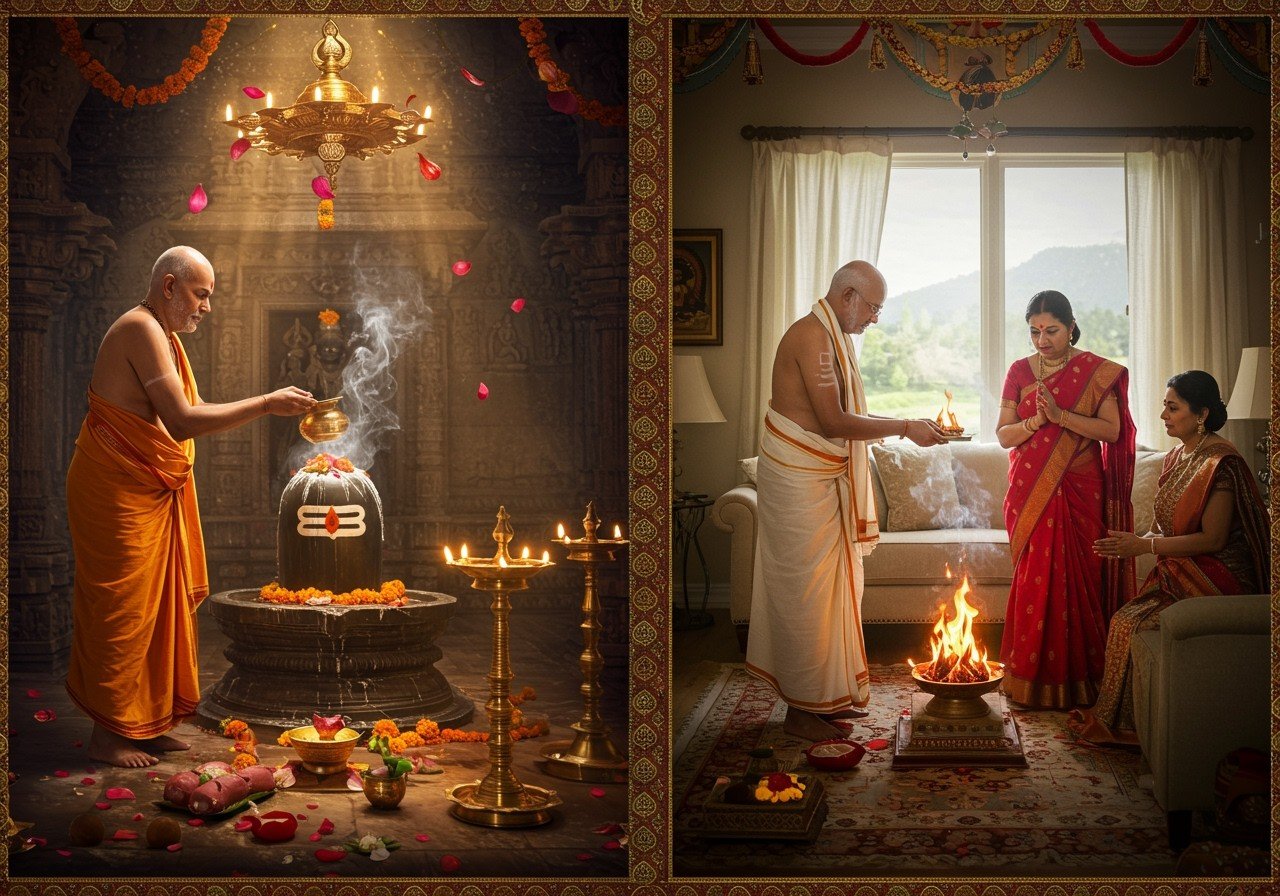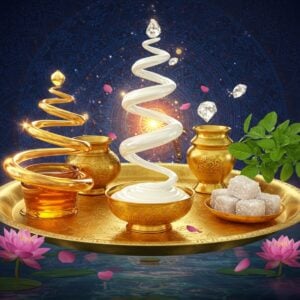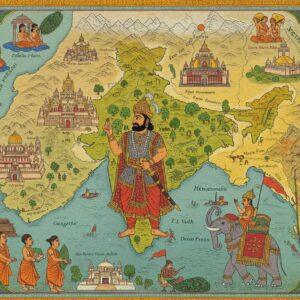
For those of us who cherish our traditions and actively participate in Hindu ceremonies, understanding the roles of the “Pujari” and “Purohit” is essential. While these terms are often used interchangeably, they represent distinct and significant positions within our rich cultural heritage. Over time, their roles may have evolved, but their importance in contemporary Indian society remains undeniable. Knowing the difference not only helps us honor these traditions but also connects us more deeply to our spiritual practices.
The Pujari: A Keeper of the Temple’s Sanctity
The Pujari, often seen as the heart of the temple, is responsible for the daily rituals and the smooth functioning of temple activities. Becoming a Pujari requires a deep understanding of Vedic scriptures and often a fluency in Sanskrit. Their daily life revolves around conducting pujas, aartis, and other ceremonies, ensuring the sanctity of the temple and caring for the deities. They are the custodians of the divine, maintaining the upkeep of the temple premises and creating a sacred space for devotees. Beyond ritualistic duties, Pujaris often provide spiritual guidance, interacting with visitors and facilitating their worship. It’s worth noting that the specific responsibilities of a Pujari can vary regionally across India.
The Purohit: Guiding Families Through Life’s Sacred Moments
The Purohit acts as a personal priest, dedicated to the spiritual well-being of families and communities. Unlike the Pujari, whose duties are primarily within the temple, the Purohit’s role extends beyond the temple walls, reaching into homes and community spaces. They conduct specific ceremonies and rituals for individuals or families, such as weddings, thread ceremonies, and funerals. Their deep knowledge of Vedic rituals and astrology guides families through significant life events, ensuring these moments are infused with spiritual meaning.
The role of a Purohit is steeped in tradition, often passed down through generations, fostering deep-rooted bonds with families. They provide personalized religious services, acting as advisors and spiritual guides. A Purohit offers guidance on auspicious dates and times, aligning ceremonies with celestial energies, an aspect deeply valued in Hindu traditions. This unique relationship, built on trust and respect, often forms the very foundation of family traditions.
Comparing the Roles: Pujari and Purohit
While both Pujaris and Purohits play vital roles in preserving Hindu traditions, their functions are distinct yet complementary. The Pujari is connected to the temple, while the Purohit attends to the individual needs of families. Their settings differ significantly: one thrives in the communal atmosphere of a temple, the other in the intimate setting of family gatherings.
-
Focus of Expertise: A Pujari’s expertise lies in temple rituals, while a Purohit specializes in personalized ceremonies, both contributing uniquely to the rich tapestry of Hindu practices.
-
Setting: A Pujari serves the community within the temple, while a Purohit caters to families in their homes and community spaces, ensuring that spirituality permeates all aspects of life.
Interdependence and Shared Purpose
Pujaris and Purohits, though distinct in their roles, often work together, particularly during festivals or large community events. They share a mutual respect, ensuring the harmony and smooth execution of religious practices. Their combined efforts ensure every ritual is performed with precision and reverence.
Both roles share the common goal of nurturing spiritual growth within the community. They play a vital role in educating people about religious knowledge, ensuring traditions are not only preserved but understood and carried forward through generations.
Adapting to Modern Times
In today’s world, Pujaris and Purohits have shown remarkable adaptability, embracing technology to connect with devotees across geographical boundaries. Virtual ceremonies have become increasingly common, enabling the Indian diaspora to connect with their roots and participate in rituals from anywhere in the world.
-
Global Reach: The increasing use of online platforms allows Pujaris and Purohits to bridge distances and cater to the needs of the Indian diaspora worldwide, ensuring that our traditions continue to flourish even far from home.
-
Formalized Education: Despite the challenges of modern times, these sacred roles remain highly relevant, with formal education and training programs ensuring their continuity and professional development.
By understanding the unique contributions of Pujaris and Purohits, we deepen our connection with our heritage. This understanding fosters a richer engagement with religious practices, allowing us to truly honor the essence of Hinduism. As we navigate the complexities of modern life, the Pujari and Purohit remain steadfast beacons of tradition, adapting to our evolving needs while upholding the sacred duties that form the bedrock of our spiritual lives. By appreciating their distinct roles, we honor the timeless traditions they represent and nurture our own spiritual journeys.
Understanding the Science Behind Puja for Holistic Well-being
The Science of Puja: How Rituals Enhance Well-being
Poojn.in: Simplifying Your Puja Needs
At poojn.in, we understand the importance of having everything you need for your pujas, whether you’re engaging a Pujari or a Purohit. We’ve made it easier than ever to prepare for these sacred occasions:
-
Complete Puja Kits: Save time and ensure you have everything required with our pre-assembled dashakarma kits. These kits are thoughtfully curated with all the essential items for specific pujas.
-
Expert Guidance: Not sure what you need? Our team is here to help! Call us at 03369029784 or WhatsApp 9476142738 for personalized assistance in selecting the right items based on your chosen priest’s requirements.
-
Quality Assurance: We source all our products from trusted suppliers, ensuring they meet the traditional standards required by both Pujaris and Purohits. You can trust in the authenticity and quality of every item.
-
Convenient Online Shopping: Browse our wide selection of authentic puja items from the comfort of your home and enjoy doorstep delivery across India.
Related Products Available at Poojn.in:
- 100% Pure Hanuman Sindoor
- Handmade Manasa Puja Ghat
- Saraswati Puja Dashakarma Kit
- Complete Puja Thali Sets
- Traditional Vastra (Clothing) for Deities
- Pure Copper and Brass Puja Items
- Authentic Puja Ingredients
Visit www.poojn.in to explore our complete collection or contact us directly for personalized assistance with your puja needs.
FAQs: Pujari vs. Purohit: Addressing Common Queries
What is the primary role of a Pujari? A Pujari is primarily responsible for performing *pujas* (daily worship and rituals) in temples, maintaining the temple’s sanctity, and caring for the deities. Their daily lifestyle consists of performing prayers multiple times a day and conducting rituals for cleansing, offerings, and blessings.
What does a Purohit do? A Purohit has a broader role in society, including performing sacrifices to the gods, possessing literacy in scriptures, and adhering to a strict diet. Purohits conduct specific ceremonies and rituals for individuals or families, such as weddings, funerals, and housewarming ceremonies. They also guide society by educating people and providing knowledge..
Is a Pandit the same as a Pujari or Purohit? The term “Pandit” generally refers to a learned scholar, particularly in Hindu scriptures and philosophy. A Pandit might serve as a Pujari or Purohit, but not all Pandits take on those roles. Some may focus on teaching, studying, or other scholarly pursuits.
Can a Pujari and Purohit be the same person? Absolutely. In some communities, especially smaller ones, one individual might fulfill both roles, serving as the temple priest and also conducting personal ceremonies for families.
Do Pujari and Purohit have equal importance? Both roles hold deep significance in Hindu traditions. Their relative importance can depend on the context and specific needs of the community. In some cases, the temple priest may be seen as central, while in others, the family priest’s guidance is paramount.
Are Pujari and Purohit titles interchangeable? While sometimes used interchangeably in casual conversation, “Pujari” specifically refers to one who performs puja, especially in a temple. “Purohit,” on the other hand, carries the connotation of a priest who guides families through life cycle rituals. Understanding this distinction helps in showing proper respect and acknowledging the specific expertise of each.
Do Pujari and Purohit require special training? Yes. Both Pujaris and Purohits undergo training in Vedic rituals, mantras, and scriptures. This training can involve years of study and apprenticeship, developing the deep knowledge and skills necessary to perform their sacred duties effectively.


